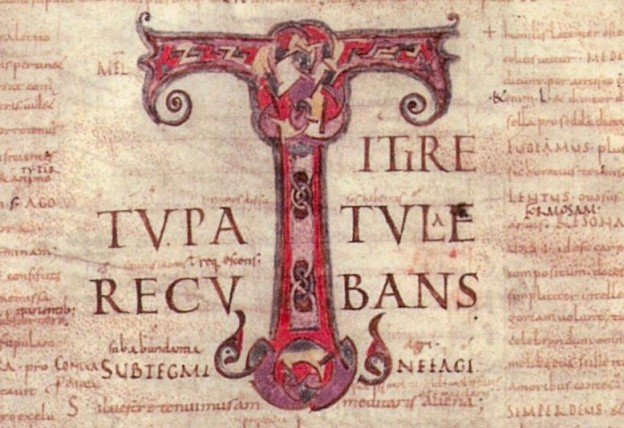| SIGNATURE |
Città del Vaticano, Biblioteca Vaticana, Reginensis latinus 1669 |
| DATE |
IX2-IX3/4 (Bischoff : Pellegrin 1978, 347 n. 1) |
ORIGIN
LOCATION
POSSESSORS |
Reims (Bischoff: Pellegrin 1978, 347 n. 1)/ Fleury (Pellegrin 1978, 349 n. 1).
The manuscript was probably copied in Reims, as it displays elements and features that may be connected to the local scriptorium (Ottaviano 2009, 260). The content of f. 192r., however, was probably copied in Fleury, thus supporting the hypothesis that the book was later owned by the library of that abbey.
Reg. lat. 1669, like many manuscripts from Fleury, became part of Pierre Daniel’s collection, as can be gathered from Daniel’s autograph annotations and from the ex libris written by his brother François (f. 4r: «ex libb. Fran(cisci) Danielis Aurelii»; f. 191v: «sum Francisci Danielis Aurelii»).
The book was subsequently included among the possessions of Paul and Alexandre Petau, whose library was acquired by Queen Christina of Sweden. The manuscript finally reached the Vatican Library as part of the queen’s legacy; it is now preserved among the Reginenses.
|
QUIRES
DIMENSIONS |
Parchment, 192 ff: quaternions, except for ff. 1-3 (13, with loss of the 2nd), ff. 156-164 (15, with loss of the 2nd), ff. 189-191 (13, with loss of 4th and 6th), f. 192 (single leaf). There is an ancient quire-signature.
Average dimensions: 318 x 255 (f. 192 : 314 x 250).
|
| LAYOUT |
Three columns on each page: one central column for the text (35 lines per page) and two side columns for the scholia.
Writing frame: 298 x 215.
|
DECORATION
TITLES
ILLUSTRATION |
f. 4r contains a coloured initial, with interlaced decoration («T»). Some titles are rubricated, some are written in archaized capital (e.g. f. 3v). f. 1r displays three diagrams. f. 21r contains a mappa mundi ( georg. 1.233).
|
| HANDWRITING |
The manuscript is written in a standard Caroline minuscule, with occasional uncial elements, ligatures and abbreviations. Four hands copied Virgil’s text: they are contemporaries belonging to the same scriptorium. Servius’ commentary was also copied at the same time.
The symbol for nota (e.g. f. 3v) occasionally employed in the manuscript recalls typologies of annotation typical of the Reims‘ scriptorium under Hincmar.
Two hands (i7, i8) intervene in f. 192 and add scattered glosses to the rest of the book. They belonged to Fleury and can be dated to around the 10th-11th century: a special abbreviation for est (– ·) and other elements recall typical writing practices of the scriptorium of Fleury under Abbo (see the wavy and angular look of the script of i8).
Glosses, scholia, corrections, variant readings and other additions can be ascribed to various hands, which can be divided into two groups:
- Early hands : i2– i5
- Late hands: i6– i9.
|
| SPECIAL SYMBOLS |
Occasional employment of a syntactical notation (sequentielle System according to Korhammer’s classification).
Now and then, figurae verborum vel sententiarum are annotated in the margin; they are mainly written in capital by i2 and their content often derives from Servius’ commentary, e.g. f. 28v (georg. 2.265): «litotes»; f. 50v (Aen. 1.118): «tapinosis»; f. 51v (Aen. 1.193): «cacenphaton»; f. 83r (Aen. 4.89); f. 85v (Aen. 4.283): «poeta dolendo»; f. 89r (Aen. 4.506): «<h>ypallage»; f. 109v (Aen. 6.346): «yronia [sic!]»; f. 118r (Aen. 7.37): «invocatio poetae»; f. 119r (Aen. 7.110): «parent<h>esis»; f. 119v (Aen. 7.142): «endiadin» [sic!]; f. 121v (Aen. 7.272): «<h>yperbole»; f. 140r (Aen. 9.3): «pleonasmus».
|
| CONTENT |
ff. 1r-2r: three diagrams from Macrobius, Commentarii in somnium Scipionis; astronomical excerpts from: Macr. Somn. Scip. (1, 21, 3-7; 2, 5, 13-14; 16-21); Bede Nat. rer. 9; Macr. Somn. Scip. 2, 7-8; Isid. Diff. 495 (= i, 2 Codoñer); Orig. 3, 60.
f. 2v: blank.f.
3r: Praefatio to the Aeneid (AL 1).
ff. 3v-191v: Eclogues, Georgics, Aeneid, without omissions or later supplements.Each work is preceded by the pseudo-Ovidian Argumentum (AL 1.2), with a prefatory monostichon in the case of the Aeneid.The Argumentum introducing Aeneid 1 is preceded by AL 634 (f. 49r).The manuscript contains Servius’ commentary in the margins, either abridged or supplemented; other hands supply more glosses and scholia.
f. 192r (X-XI sec.): AL 392. («Versus cuiusdam»); Periochae Vaticanae (Finch 1974, 56-61; Brugnoli, Stok 1991, 466-67); various glosses («xenodochium»; «vesper»; «Lucumones»; «subsicivus»; «circumcelliones»; «ectaetae [corr. exedrae?]»; «eusebia»); AL 679 («versus de xl duobus signis pomi [corr. poli] et eo amplius»).
f. 192v: probationes pennae (X-XI sec.).
|
| REPRODUCTIONS |
Brugnoli, Stok 1991, 467 (f. 192r) ; Ottaviano 2009, 317-23, TAVV. I-VII (f. 1r, 35v, part. ; f. 70r, part. ; f. 78v, part. ; f. 21r, part. ; f. 22v, part. ; f. 155r, part. ; f. 192r, part.).
|
| BIBLIOGRAPHY |
Brugnoli, Stok 1991
Brugnoli, G.,- Stok, F., Fontes in Enciclopedia Virgiliana v** (1991), 466-67.
Finch 1974
Finch, C. E., “Fragments of a new Vita Vergiliana in Codex Reg. lat. 1669”, American Journal of Philology, 95 (1974), 56-61.
Ottaviano 2009
Ottaviano, S. , “Il Reg. Lat. 1669: un’edizione di Virgilio d’età carolingia”, Miscellanea Bibliothecae Apostolicae Vaticanae, 16 (2009), 259-324.
Munk Olsen 1985
Munk Olsen, B., “L’étude des auteurs classiques latins aux xie et xiie siècles, ii, Paris 1985, 781.
Munk Olsen 1994
Munk Olsen, B. “Chronique des manuscrits classiques latins (ixe-xiie siècles)”, Revue d’histoire des textes 24 (1994), 245.
Pellegrin 1978
Pellegrin, E., Les manuscrits classiques latins de la Bibliothèque Vaticane, II. 1, Paris 1978, 347-349.
|
|
|

